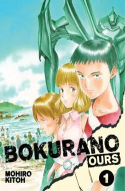 Fifteen kids—most of them, except for one boy’s kid sister, in 7th grade—are taking part in a summer program called “Seaside Friendship and Nature School.” Chafing at the instruction to go out and observe nature, the kids decide to explore a nearby cave, where they inexplicably discover a computer lab and a strange guy who calls himself Kokopelli.
Fifteen kids—most of them, except for one boy’s kid sister, in 7th grade—are taking part in a summer program called “Seaside Friendship and Nature School.” Chafing at the instruction to go out and observe nature, the kids decide to explore a nearby cave, where they inexplicably discover a computer lab and a strange guy who calls himself Kokopelli.
Kokopelli tells the kids he’s working on a game in which the “chosen heroes” will pilot a giant robot as it faces off against alien invaders, and offers them the chance to play. Of course, they’re all interested and when he asks them to seal their contract before explaining the rules, they comply. It’s only when Kokopelli’s subsequent demonstration claims the life of a fighter pilot that they begin to grasp that the battle—and the damage it causes—is real.
Over the course of these first two volumes, the kids begin to learn exactly what they’re in for. After the disappearance of Kokopelli, “assistance” is provided by (possibly untrustworthy) Koyemshi, a floating creature almost cute enough to be a plushie if not for his menacing set of pointed teeth. He doles out information sparingly, and it’s not until two of their comrades have died that the kids learn the truth: the giant robot will fight to defend humanity from the invaders, but derives the power to do so from the life force of its pilot.
Obviously, the kids want to quit, but Koyemshi points out that they signed a contract and warns that if they should refuse to fight, Earth will be destroyed within 48 hours. The same fate awaits if they should lose a battle. As he puts it, “Win, save the planet and die… or lose and die when your planet is destroyed. Those are your options.” Believing that they really are helping to save the world, the kids soldier on.
At this point, the feel of the story reminds me a lot of another VIZ Signature title, Ikigami. For those unfamiliar with the story, Ikigami envisions a Japan in which the government attempts to encourage its citizens to lead a more productive life by instilling in them the fear of death. Anyone could receive a death notice (an ikigami) at any time informing them that they have 24 hours left to live, and the series follows each recipient in turn as they deal with the news.
 Bokurano is structured similarly, focusing on each pilot as he or she “gets the call.” There are merits and flaws to this approach: obviously, the current pilot receives a lot of attention, and it’s interesting to see how each approaches the responsibility differently. One boy cares nothing for human casualties while another carefully takes the battle out into the harbor to minimize damage. One girl uses her final hours to sew morale-boosting uniforms for the group. Unfortunately, this also means that at any given time there are about a dozen characters relegated to the background, waiting for their turn to contribute to the story.
Bokurano is structured similarly, focusing on each pilot as he or she “gets the call.” There are merits and flaws to this approach: obviously, the current pilot receives a lot of attention, and it’s interesting to see how each approaches the responsibility differently. One boy cares nothing for human casualties while another carefully takes the battle out into the harbor to minimize damage. One girl uses her final hours to sew morale-boosting uniforms for the group. Unfortunately, this also means that at any given time there are about a dozen characters relegated to the background, waiting for their turn to contribute to the story.
Because of lack of time spent with individual characters, it’s hard to care about them much, despite their awful predicament. I might realize I like someone based on how he handles his turn as pilot, but I know the opportunity to see things from his perspective will be brief. The most compelling aspect of the story to me is the notion of where these invaders came from in the first place, and what the human population as a whole thinks about giant monsters in their midst.
During Kokopelli’s demonstration, as he occupies the sole chair in a circle of many, he admits that he’s as much a pawn as the kids are and that he isn’t from our planet. It would appear, then, that he is the final pilot from a previous incarnation of this “game” who was sent to Earth to find a new set of players. Is this “invasion” real? Why are there precisely fifteen enemies and no more? This may not be a game for the young pilots or the humans threatened by these monsters, but is it a game for someone, somewhere?
Dark, grim, and mysterious, Bokurano is probably not for everyone, but I’ll definitely be reading more.
Bokurano: Ours is published in English by VIZ. The series is complete in Japan with eleven volumes.
This review was originally published at Comics Should Be Good.
Review copy for volume two provided by the publisher.




Speak Your Mind